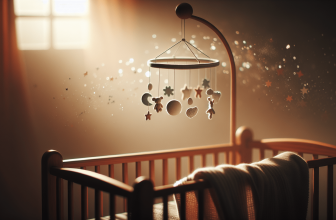In this article, you will discover how to create a safe and stimulating play area for your baby right in the comfort of your own home. We understand that as a loving parent, you want to provide the best environment for your little one to explore, learn, and have fun. By following a few simple tips and guidelines, you can ensure that your baby’s play area is both safe and filled with activities that promote their development. From choosing the right toys to setting up a secure space, we’ve got you covered. So let’s get started on creating a play area that will keep your baby happy, engaged, and protected.
Selecting a Location for the Play Area
When it comes to selecting a location for your baby’s play area, there are a few factors to consider. First and foremost, take a look at the available space in your home. Look for a space that is large enough to accommodate the play area without feeling cramped. It’s important to choose a dedicated area for the play area, rather than just scattering toys throughout the house. This helps to establish a designated space for playtime and can make it easier to keep the area organized. Additionally, try to select a location that is in a central area of your home. This will allow you to keep an eye on your baby while they play and make it more convenient for you to interact with them during playtime.
Creating a Safe Environment
Creating a safe environment is essential for your baby’s play area. Start by carefully inspecting the space and removing any potential hazards. This includes things like small objects that could pose a choking hazard, cords that could be a strangulation risk, or sharp edges that could cause injuries. Next, take steps to secure any furniture or fixtures in the play area. This can help to prevent accidents or injuries caused by tipping furniture or falling items. It’s also important to cover electrical outlets to prevent your baby from accidentally sticking their fingers or objects into them.

This image is property of images.pexels.com.
Choosing Age-Appropriate Toys and Equipment
When selecting toys and equipment for your baby’s play area, it’s important to consider their developmental stage. Babies go through different stages of development, and toys that are appropriate for one stage may not be suitable for another. Opt for toys that encourage exploration and stimulation, such as colorful toys with different textures or toys that make sounds. Including a variety of toys that target different senses can help to provide a well-rounded sensory experience for your baby.
Setting Up the Play Area
Setting up the play area involves a few key steps. First, consider installing play mats or soft flooring to provide a comfortable and safe surface for your baby to play on. This can help to cushion any falls and reduce the risk of injuries. Additionally, include storage solutions in the play area to keep toys organized. This can be as simple as baskets or bins to quickly and easily put away toys when playtime is over. Lastly, creating different zones within the play area can help to cater to various activities. For example, you might have a reading corner with a cozy chair and a small bookshelf, a sensory play area with different textured toys, and a gross motor play area with soft climbing blocks or a mini slide.

This image is property of images.pexels.com.
Creating a Sensory Experience
A sensory experience is important for your baby’s development and can be incorporated into their play area. One way to do this is by incorporating different textures into the toys and materials in the play area. This can include toys with different fabrics, surfaces, or shapes. Introducing music and sound can also enhance the sensory experience. You can include toys that play music or provide different sounds, or even have a small sound machine or musical instrument in the play area. Additionally, including visual stimulation can be beneficial. Hang up colorful mobiles or posters with bright images to capture your baby’s attention and stimulate their visual senses.
Ensuring Proper Supervision and Safety Measures
While creating a safe play environment is important, it’s equally important to ensure proper supervision during playtime. Always keep a close eye on your baby while they are playing, even if the play area is secure. Babies can move quickly and accidents can happen. Implementing safety gates or barriers can help to limit access to certain areas of your home and provide added security. If you have older siblings or pets, it’s crucial to teach them how to interact safely with the baby during playtime. This can help prevent any accidental injuries or incidents.

This image is property of images.pexels.com.
Promoting Cognitive Development
Playtime is not only about fun and entertainment, but it also plays a crucial role in your baby’s cognitive development. Engaging in interactive play with your baby can help stimulate their brain and foster cognitive skills. This can involve playing games like peek-a-boo, stacking blocks, or playing with shape-sorting toys. Encourage problem-solving and exploration by providing toys and activities that require your baby to figure things out or manipulate objects. Additionally, introducing books and reading can help promote early literacy skills and language development. Include board books or soft books in the play area and take time to read to your baby regularly.
Encouraging Physical Activity
Physical activity is important for your baby’s overall development and playtime is a great opportunity to encourage movement and physical exploration. Provide opportunities for crawling and tummy time by clearing a safe space on the floor and placing toys within reach. This can help strengthen their muscles and promote gross motor skills. Include toys that promote gross motor skills, such as activity tables with buttons to push or balls to roll. It’s also important to allow for free movement and exploration. Avoid restricting your baby’s movements too much and give them the freedom to explore their surroundings and develop their motor skills.
Creating a Peaceful Atmosphere
In addition to creating a safe and stimulating play area, consider creating a peaceful atmosphere for your baby. Dimming the lights or using soft lighting can create a relaxing environment. Avoid bright, harsh lights that can be overstimulating. Playing soothing music or white noise can also help create a calming atmosphere. This can be done through a small Bluetooth speaker or even a white noise machine. By minimizing distractions from the surrounding environment, you can create a more focused and peaceful playtime experience for your baby.
Regularly Updating and Rotating Toys
To keep playtime exciting and engaging for your baby, it’s important to regularly update and rotate their toys. Introduce new toys every so often to keep their interest piqued. This can be done by purchasing new toys or borrowing toys from friends or family. Additionally, rotating toys can also help to maintain your baby’s interest. Rather than having all the toys out at once, store some in a closet or container and rotate them every few weeks. This can make each playtime feel fresh and new for your baby. Lastly, make sure to regularly clean and sanitize the toys, and remove any that are broken or damaged to ensure a safe and enjoyable play experience.








